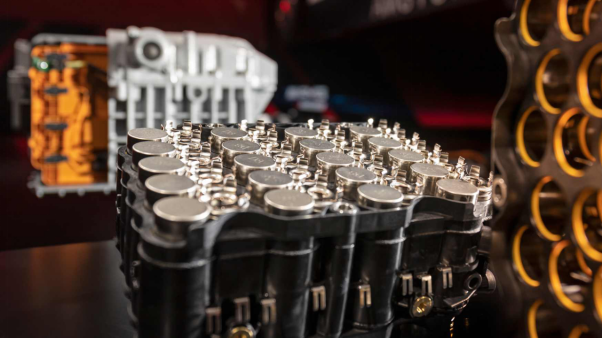Description

Disclaimer: Copyright infringement not intended.
Context
The Ministry of Heavy Industries (MHI) successfully convened a pre-bid meeting in New Delhi, laying the foundation for the second round under the Production Linked Incentive (PLI) scheme for Advanced Chemistry Cells (ACC) for cumulative 10 GWh PLI ACC capacity.
Details
- The Production Linked Incentive (PLI) scheme, National Programme on Advanced Chemistry Cell (ACC) Battery Storage, was approved by the Union Cabinet on May 12, 2021, with a budgetary outlay of Rs. 18,100 crores.
- This scheme aims to strengthen India's ecosystem for electric mobility and battery storage by enhancing the country's manufacturing capabilities in Advanced Chemistry Cells (ACC) through the establishment of Giga-scale ACC and battery manufacturing facilities with a focus on maximum domestic value addition.
- The scheme aligns with the Make in India initiative, promoting indigenous manufacturing and reducing dependence on imports.
Key features of the PLI scheme for ACC battery storage include:
- Budgetary Outlay: The scheme has a budget of Rs. 18,100 crores to support the establishment of ACC manufacturing facilities in India.
- Domestic Value Addition: Beneficiary firms are required to ensure a domestic value addition of at least 25% initially, increasing to 60% within five years. This emphasizes the importance of utilizing domestically sourced materials and components.
- Investment Commitment: Beneficiary firms must make a mandatory investment of Rs. 225 crore per Gigawatt-hour (GWh) of committed capacity within two years of the scheme's implementation.
- Gestation Period and Performance Period: The scheme includes an initial two-year gestation period from the Appointed Date (AD) (January 1, 2023, to December 31, 2024), followed by a five-year performance period (January 1, 2025, to December 31, 2029).
- Capacity Allocation: Initially, three beneficiary firms have been allocated a total capacity of 30 GWh. However, 20 GWh of capacity is available for fresh allocation, indicating opportunities for new entrants or additional investments.

About ACC
- Advanced Chemistry Cells (ACCs), also known as advanced chemistry cell batteries, are a crucial component of lithium-ion batteries and other energy storage systems.
- They are characterized by their advanced chemistry, which allows them to store electric energy either as electrochemical or chemical energy and convert it back to electric energy as needed.
- ACCs play a significant role in reducing dependence on fossil fuels and mitigating global warming by enabling the widespread adoption of clean energy technologies.
- It is a nascent technology that holds immense potential in the fight against climate change.
- India, recognizing the importance of ACCs in transitioning to a clean energy economy, has launched the National Programme on Advanced Chemistry Cell (ACC) Battery Storage to reduce import dependence on these critical components.
- The government has introduced a production-linked scheme (PLI) to incentivize domestic manufacturing of ACCs, attracting interest from various companies.
- Advanced Chemistry Cell offers improved energy density, longer lifespan, and enhanced safety compared to traditional battery chemistries like lead-acid or nickel-metal hydride (NiMH).
Types of Advanced Chemistry Cells:
- Lithium-ion (Li-ion) Batteries:
- Li-ion batteries are the most common type of ACCs and are widely used in numerous applications due to their high energy density, light weight, and relatively low self-discharge rate.
- Variants include lithium iron phosphate (LiFePO4), lithium cobalt oxide (LiCoO2), lithium manganese oxide (LiMn2O4), and lithium nickel cobalt aluminum oxide (NCA).
- Lithium-Sulfur (Li-S) Batteries:
- Li-S batteries utilize sulfur as the cathode material, offering significantly higher theoretical energy densities compared to Li-ion batteries.
- Challenges include polysulfide dissolution, low electrical conductivity of sulfur, and issues related to cycle life and stability.
- Solid-State Batteries:
- Solid-state batteries replace the liquid or gel electrolyte found in traditional Li-ion batteries with a solid electrolyte, offering improved safety and potentially higher energy density.
- Solid electrolyte materials include ceramics, polymers, and composites.
- Lithium-Air (Li-air) Batteries:
- Li-air batteries have a lithium anode and use oxygen from the air as the cathode material, theoretically offering extremely high energy densities.
- Challenges include electrolyte stability, cathode degradation, and issues related to practical implementation.
- Sodium-ion (Na-ion) Batteries:
- Na-ion batteries are similar to Li-ion batteries but use sodium ions instead of lithium ions, potentially offering lower cost and greater abundance of materials.
- Challenges include lower energy density compared to Li-ion batteries and issues related to electrode materials.
Working Principles:
- The working principles of Advanced Chemistry Cells vary depending on their specific chemistry but generally involve the reversible electrochemical reactions between the anode and cathode materials during charge and discharge cycles.
- During discharge, ions move from the anode to the cathode through the electrolyte, creating a flow of electrons through the external circuit, which can be utilized to power electronic devices.
- During charging, this process is reversed.
Applications:
- Electric Vehicles (EVs): ACCs are increasingly used in EVs due to their high energy density, enabling longer driving ranges and faster charging times.
- Renewable Energy Storage: ACCs play a crucial role in storing energy from renewable sources such as solar and wind power for later use, helping to stabilize the electrical grid.
- Portable Electronics: ACCs power a wide range of portable electronic devices such as smartphones, laptops, and tablets due to their high energy density and compact size.
- Grid Stabilization: ACCs can be used for grid stabilization by providing energy storage for load balancing, frequency regulation, and peak shaving.
Advantages:
- High Energy Density: ACCs offer higher energy densities compared to traditional battery chemistries, providing more energy storage capacity per unit weight or volume.
- Longer Lifespan: ACCs typically have longer cycle life and calendar life compared to traditional batteries, resulting in reduced replacement costs and environmental impact.
- Improved Safety: Advanced chemistry cells often feature enhanced safety features such as stable electrolytes and solid-state designs, reducing the risk of thermal runaway and fire hazards.
- Fast Charging: Many ACCs support fast charging capabilities, allowing for rapid replenishment of energy, which is especially beneficial in EVs and portable electronics.

Challenges:
- Cost: Despite advancements, ACCs can still be more expensive to manufacture compared to traditional batteries, limiting their widespread adoption, particularly in large-scale applications.
- Material Availability: Some ACCs rely on materials that are scarce or costly to extract, which could pose challenges for scalability and sustainability.
- Technical Hurdles: Certain ACCs face technical challenges such as limited cycle life, poor rate performance, and safety concerns, requiring further research and development efforts.
- Environmental Impact: While ACCs offer environmental benefits compared to fossil fuels, their production and disposal can still have environmental impacts, particularly if not managed properly.
Conclusion
The PLI scheme for ACC battery storage is designed to incentivize domestic manufacturing, promote technological innovation, and contribute to India's efforts in achieving self-reliance in the electric mobility and battery storage sectors. It aims to create a conducive environment for the growth of the ACC industry, foster collaboration between industry and government, and position India as a global leader in advanced battery technology.
|
PRACTICE QUESTION
Q. Discuss the significance of the National Programme on Advanced Chemistry Cell (ACC) Battery Storage and the Production Linked Incentive (PLI) scheme in India's pursuit of promoting clean energy and self-reliance. Also, analyze the challenges and opportunities associated with the implementation of these initiatives.(15 marks)
|











